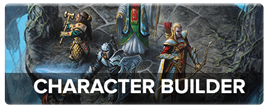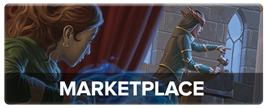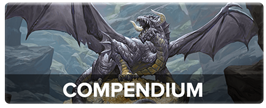Welcome to the latest installment of New Player’s Guide. This week, we’re talking about customizing and reflavoring spells, a skill that every D&D player should have. Official D&D supplements are made for a mass audience, so players that want to tailor their gaming experience to their preferences and playstyle should be familiar with how to do that using D&D Beyond’s digital toolset.
Sometimes you may wish to modify an existing spell that you own on D&D Beyond. Whether you want to change your fireball into an iceball that deals cold damage, or make cure wounds a spell any spellcaster can use (or limit its usage even more, so only clerics can use it), here is one method that I have found pretty effective that I use for my own campaigns. I hope you'll find it helpful as well!
Step One: Create a Spell
If you haven't made any homebrew before, you might not know where to start, and that's alright!
If you're on a desktop you can go to "Creations" in the top menu, and select "Create a Spell".
If you're using a smaller screen device, like your phone, you'll select "Creations" from the side menu, and then "Browse and Create Homebrew". From there you can find an option in the list to create a spell. IMPORTANT: If using a small screen, change your view to "Landscape" mode! You'll be missing some options when viewing in Portrait mode.
Step Two: Making a Copy
Now that you're in the page for making spells, you can choose a spell to make a copy of! What's very important here is that you need to own the spell on D&D Beyond in order to make a copy. This doesn't include content being shared with you. If you don't own the spell, you can purchase either the book it is from, or the spell itself from the D&D Beyond Marketplace.
If you do own the spell, you can now begin to search for it in the drop-down list. Once you find the spell you want, go ahead and click "Create"!

Step Three, Part A: Changing a Spell's Effects
So, let's jump back to the idea of making a spell have a different effect. In this case, I'm changing the fireball spell into an iceball! First thing is that I'm going to change the description itself to read "cold" instead of "fire" damage, and of course change the name to "Iceball". You can also play around with other flavor text or material components at this point. Once I'm satisfied, I'll press the “Save Changes” button before doing anything else.

Everything we’ve just changed here affects the spell’s body text. That’s great for the humans reading the spell, but now it’s time to change the spell in ways that the code running the D&D Beyond Character Sheet will understand. Let’s look at the modifiers—the things that make the content function on the character sheet. Fireball here has a "damage" modifier that tells the character sheet that the spell deals fire damage. I'm going to change that to cold. So I'll edit the modifier, and in there I'll choose "cold".

Once I'm satisfied, I can go ahead and check my work, and then "Save" again, and now I can move on to Step Four! I’m only using iceball for one character, a wizard, and I don’t want anyone else to be able to cast this spell.
Tip from the Editor: Damage Types
Every effect that deals damage has a damage type, but not all damage types are created equal. Some damage types are frequently resisted or ignored entirely by entire monster types, so changing the damage a spell deals from one type to another isn’t always as straightforward as it seems. Let’s stick with fireball as an example, but this advice is useful for all spells and magical effects that deal damage.
The damage dealt by spells can be divided into three unofficial categories: elemental damage, mystical damage, and force damage.
Elemental damage types include acid, cold, fire, lightning, and thunder damage. Lots of creatures have either resistant or vulnerable to one or more of these damage types. Fiends are a particularly notable example of creatures with many elemental resistances. You can swap out any of these damage types for one another without any issues. So, just by swapping basic damage types, you could easily make your fireball an acidball, an iceball, a voltball, or a thunderball.
Mystical damage types include the necrotic, psychic, and radiant damage, as well as magical bludgeoning, piercing, and slashing damage. Creatures rarely resist these damage types, but are rarely vulnerable to them either. This makes them very consistent and useful damage types that a spellcaster can always rely upon. This reliability makes them more powerful than elemental damage types, broadly speaking. If you want to modify fireball’s damage type to create a death burst (necrotic), a psychic bubble (psychic), or a sun spot (radiant), consider lowering the spell’s damage by one or two dice to keep it balanced.
Also, magical bludgeoning, piercing, and slashing damage is roughly the same power level as these mystical damage types. Lots of creatures resist nonmagical bludgeoning, piercing, and slashing, but few have any protection against magical versions of this damage. So, you could turn your fireball into a bursting boulder (bludgeoning), a burst of needles (piercing), or a burst of blades (slashing) by following the guidelines above.
Force damage is in a class of its own. No creature in the game is resistant to this damage type, and only three very rare creatures in all of D&D are immune to it. When you change a spell’s damage type to force, you’re essentially guaranteeing that any creatures caught in its blast will take full damage. This is such a serious power boost that changing a spell’s damage type to force is generally enough to increase its spell level by 1.
Step Three, Part Two: Spell Availability
We’ll be making iceball a wizard-only spell, so that none of the other classes that get access to fireball can use this alternate version. This is useful if you’re a Dungeon Master modifying a spell for an NPC’s use, but don’t want your players to be able to use it. (If you have Content Sharing turned on for your campaign, your players will be able to see your homebrew, for instance.) In that same spell editing field, you can see a small box in the corner that has those classes listed in it. And that's what I'm going to change!
First off: I’m going to be removing all of the classes that ALREADY had access to the spell. They may have fireball, but I don’t want them to have iceball! Fortunately, wizard is already on that list. If it wasn’t, though, it would be easy enough to just put “Wizard” in the “Available for Classes” field to add it to the wizard spell list. Take a look at this example, in which I’m adding cure wounds to the wizard spell list—first I take off all the other classes (so the cure wounds spell doesn’t appear twice on their spell lists) and then I add it to the wizard class.

Once I've done that, I'll SAVE CHANGES! That will now make the spell available to the classes I've listed there.
Step Four: Check Your Work!
Time to make sure that everything is working as intended. Hop into one of your characters, and ensure that "Homebrew Content" is turned "On".

Now we can set up the character to check these spells! Both iceball and cure wounds are now available to wizards, so let's make a wizard character to test it out. Once I make my wizard at the right level (they need to be a 5th-level wizard to learn iceball, after all) I'm going to manage spells and see if I can find these available on the list. Here's what I find:

Success! If you're not able to find your new spells, double-check your work in the previous steps, and feel free to reach out here on our forums, or in our Discord community for some extra help!
Step Five: Don't Publish!
Do NOT publish your homebrew copies of spells! You don’t actually need to; your private homebrew will be shared automatically in campaigns you're a part of, either as a player or a DM. Publishing is only for your original work, and the D&D Beyond Homebrew system will just reject your homebrew if it’s too similar to an official spell anyway.
That’s all you need to know about And that's it! I hope that was helpful in learning how to modify existing spells to best fit your own campaign's special rules and exceptions!
Tips for Homebrew Masters and Prolific Players
If you're like me, you might be a part of a LOT of campaigns, which have different homebrew options in each. Because of this, you may want to add a couple extra steps which will help you ensure that the homebrew spells you make in this way are clearly for just the campaign you want it to be for. Here are the methods I personally use:
Method One: Label Your Homebrew!
I make tons of homebrew for my DMs and my own games. To help groups know at a glance what is a valid choice, and what isn't, I add labels to the names of my homebrew! So let's jump back to iceball, which is a spell I might make available in my campaigns, but that my DMs might not. I'm going to edit the name, and change it to something like this...

Now when I hop into my wizard character, I can see this really clearly labelled! And if I don't want that label to persist on my character sheet all the time I can use the on-sheet "Customize" option and change the name, so it shows really simply on the sheet itself:

There you go! With just a little name change, and communicating to your groups what to look out for, you can easily create lots of homebrew and ensure that none of your fellow players or DMs get confused.
Method Two: Remove From Collection
This is a great method for those homebrew spells you're making to serve just one character. Let's go back to cure wounds as an example. Maybe I, as a DM, gave my wizard knowledge of how to cast cure wounds as a quest reward, so I want them to be able to add the spell into their spellbook. However, I don't want this to be available for every wizard I ever DM for. So labelling won’t work as well here. Instead, I'm going to do this!
Once the content is created (and double-checked to make sure it's working!) you'll want to have the player add the new content to their sheet. Once you've made sure it's been added, you can then go to your Homebrew Collection. In there, look for the spell in question-- For me, I'll be using my homebrew version of cure wounds.

Now that I've found it, I'm going to expand it by either clicking in its row, or using that plus (+) symbol at the end, which will show me my spell in full. At the very bottom of the description you'll see two options: View Details Page, and Remove From Collection. The option you'll want to click is Remove From Collection!

Once you do that, the character (or characters) that already have the spell added will keep the spell from the source they added it from, whether that's from their class spellcasting feature, or from some other feat or feature that granted them access.
Important: If the spellcaster is a "prepared" caster that knows all their spells like an artificer, cleric, druid, or paladin, and they unprepare the spell, you will need to add it back to your collection for them to prepare it again.
That's All, Folks!
I hope that my methods of modifying spells and organizing them has helped you and your campaign out somewhat. The D&D Beyond homebrew tools offer a lot of options to DMs and players to customize their campaigns, so go ahead and explore them and see what cool things you can do! This is just the tip of the homebrew iceberg, but it’s a great start for new players.
If you ever run into problems with homebrew, or can't figure out how to do something, the community is here for you! We have a Homebrew section of our forums where you can look for help, as well as a Homebrew Discussion channel on our community Discord!
Want more homebrew tips? Check out Design Workshop, a series on homebrewing on D&D Beyond—and let us know if you still have questions in the comments!
Create A Brand-New Adventurer Acquire New Powers and Adventures Browse All Your D&D Content
 Melissa Doucette is a D&D Beyond moderator and social media monitor. The legends say that when she's not looking for new ways to use D&D Beyond's tools in her numerous games, she's singing musical numbers with the aid of her cats. You can find her on Twitter at @melliedm.
Melissa Doucette is a D&D Beyond moderator and social media monitor. The legends say that when she's not looking for new ways to use D&D Beyond's tools in her numerous games, she's singing musical numbers with the aid of her cats. You can find her on Twitter at @melliedm.











-
View User Profile
-
Send Message
Posted Jul 24, 2020Essentially, unless you are playing in certain adventures, one.
-
View User Profile
-
Send Message
Posted Jul 30, 2020I appreciate the article, but I'm curious.... There are many spells in the game that let you choose from a list of damage types. I have tried, when playing a caster, to pick a damage type other than the default, but there appears to be no drop down for this. When I have tried to search for an answer, I mostly get articles like this one, explaining how to home brew a spell. But there must be a simple way to change the damage type of a spells that says in the description you can pick the type of damage you want to occur. Am i missing a really simple button or checkbox to make this happen?
-
View User Profile
-
Send Message
Posted Jul 31, 2020Very new to this, and this was so helpful in clearing up my general questions. Greatly appreciated!
-
View User Profile
-
Send Message
Posted Aug 4, 2020It doesn’t matter too much, but I didn’t see the poison damage type mentioned when talking about changing damage types. Thanks!
-
View User Profile
-
Send Message
Posted Aug 6, 2020I sat down at one point and compiled all of the resistances, vulnerabilities, and immunities in the Monster Manual, to see how all the damage types compared. These were the groupings that emerged:
Poison (about 80% as effective as untyped damage)
Fire, Cold, Lightning (about 90% as effective as untyped damage)
Acid, Necrotic (about 95% as effective as untyped damage)
Psychic, Thunder, Magical Slashing/Piercing/Bludgeoning, Radiant, Force (about as effective as untyped damage)
Any of the damage types in that last category is basically as good as force damage; resistance and immunity to them are vanishingly rare. Radiant in fact came out slightly ahead of force, due to a couple of creatures having vulnerability to radiant and nothing being immune.
-
View User Profile
-
Send Message
Posted Aug 6, 2020Poison is in a category all its own, significantly weaker than any other type. Whole classes of monsters (constructs, undead, demons, etc.) are totally immune to poison.
-
View User Profile
-
Send Message
Posted Aug 8, 2020And reduced threat helmed horror plus helmed horror is basically just one monster with a variant
-
View User Profile
-
Send Message
Posted Aug 14, 2020I noticed James Haeck doesn’t mention Poison in his hierarchy of damage types. I assume it is weaker than those already mentioned. It would be nice if he’d said how much weaker – is it worth +1 or 2 dice, a dice category (say d6 to d8?) or a spell level?
-
View User Profile
-
Send Message
Posted Aug 14, 2020Puh-lease. Thunder is miles better than fire.
D&D has over 4 times as many creatures resistant or immune to fire (16 pages on d&dbeyond) than there are to thunder (4 pages), and while more are vulnerable to fire, that list is pretty short and mostly consists of low-CR creatures (CR 1 or less are over half the list).
Elemental damages are not equal.
-
View User Profile
-
Send Message
Posted Aug 27, 2020The magical weapon damage types are the same level as the mystical damage types
-
View User Profile
-
Send Message
Posted Sep 1, 2020I would say to add one or two damage dice, or maybe give it an extra effect--poisoned condition is pretty standard for poison spells, since it's also a common immunity, but can really hurt those that aren't immune. Also fyi this article isn't by James Haeck, it's by Melissa Doucette :)
-
View User Profile
-
Send Message
Posted Sep 29, 2020-
View User Profile
-
Send Message
Posted Sep 29, 2020Okau
-
View User Profile
-
Send Message
Posted Dec 9, 2020I would say, based both on a review of the database of monsters and personal experience, that acid is slightly more versatile than fire/Lightning/Cold. Thunder is MUCH more versatile than the other elemental types, and Necrotic a hair below psychic.
Radiant is almost as good as force - about the only things resistant to it are celestials, which are extremely rare opponents in most campaigns. Radiant damage also frequently has additional effects against some undead enemies.
I would tier damage types up as:
Tier 0: poison; Tier 1: Fire/Lightning/Cold; Tier 2: Acid/Necrotic/Psychic; Tier 3: Thunder/Magic BSP; Tier 4: Radiant/Force
-
View User Profile
-
Send Message
Posted Dec 9, 2020@Helmut_McQuack
I see your question about giving Paladins and Rangers cantrips. If you don't have Tasha's Cauldron of Everything yet, there are new "fighting style" options for these classes that give the character 2 cantrips from the Cleric or Druid lists, respectively.
-
View User Profile
-
Send Message
Posted Jan 17, 2021This is the most recent post by an author other than mr. Haeck, and it was way back in July, 2020. Mr. Haeck has single-handedly carried D&D Beyond’s articles. Now that he’s left, who now?
-
View User Profile
-
Send Message
Posted Mar 26, 2022What three creatures have immunity to force damage?
-
View User Profile
-
Send Message
Posted Mar 27, 2022The Helmed Horror is the only one from the Monster Manual. There are a couple variants of it in the Mad Mage and Yawning Portal books. The new Fizban's Treasury also has a great wyrm dragon that's immune to force.